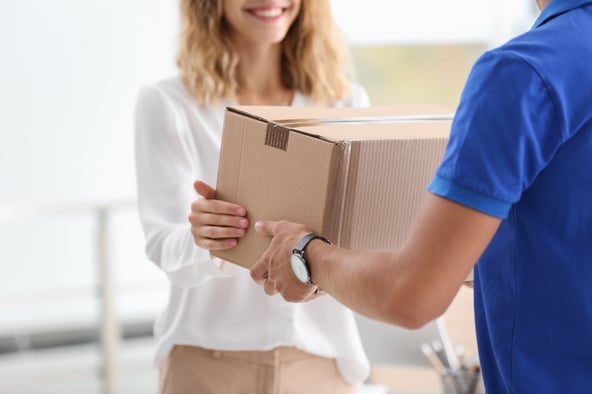From Amsterdam to Tallinn: Environmentally friendly and convenient – this is how the majority of online shoppers want their parcels delivered. The carriers' sustainable concepts for last-mile delivery show that environmental awareness and customer-oriented delivery do not have to be a contradiction in terms.
According to DPD’s latest E-Shopper-Barometer 2019 66 percent of the 23,000 respondents from 21 countries said that when shopping online they preferred brands and retailers who lived up to their responsibility when it came to environmental protection.
At the same time, 92 percent said they would prefer to have their goods delivered to their doorstep. “Environmental protection is therefore also a key factor in customer satisfaction for online shoppers,” explains Dr. Johannes Plehn, founder and CEO of Seven Senders.
“Last mile carriers are focusing on two areas in order to meet both customer needs." The more than 100 last-mile carriers in the Seven Senders network are increasingly investing in environmentally friendly delivery vehicles and avoiding environmentally damaging multiple journeys by using pick-up points, more precise delivery time windows, or real-time tracking. Below are a few examples of sustainable delivery concepts both off- and online.
Environmentally friendly delivery vehicles for town and country
In January 2020, the World Economic Forum published a study on the “Future of Last Mile Services“*. According to the study, the demand for last mile deliveries in cities around the world will increase by 78 percent by 2030. This increase in last mile services will also mean that in 2030 a total of 36 percent more delivery vehicles will be on the roads of the world’s 100 largest cities than in 2019.
This increase in vehicles alone would raise CO2 emissions by 6 million tonnes to 25 million tonnes in 2030. The conversion of delivery fleets to low-emission or zero-emission vehicles could reduce the expected increase in CO2 emissions over the last mile by up to 60 percent, as the authors* of the study emphasize.
Consequently, carriers worldwide are opting for zero-emission or lower-emission vehicle types. The internationally operating carrier DPD, for example, operates exclusively with low-emission vehicles in the metropolis of Paris. In London, the company plans to expand its electric fleet to 278 electric cars by the end of the year. In Tallinn, with a population of around 400,000, the company is relying on a mixture of packing stations and delivery robots.

Green delivery regional carrier
It is not only the big players who are addressing the issue of “green delivery” on the last delivery mile. Due to the geographical conditions in Switzerland, Carrier Quickpack uses only electric cars and does not use bicycles. According to the company, the fact that the fleet of around 100 vehicles is quiet also enables trouble-free delivery in the evening hours for the neighbors. The latter service is offered in order to reduce multiple journeys.
Budbee, a carrier operating in Denmark, Sweden, and the Netherlands, plans to convert its delivery fleet completely to electric vehicles by 2025. Stuart, a French carrier, relies on independent bicycle couriers in the major cities, who deliver seven days a week and in the evening hours and also collect parcels from the end customer.
Pick-up 24/7
Pick-up points in shops or parcel stations offer an alternative to delivery to the front door, especially for younger, mobile customers. Parcel stations can be used around the clock – 24 hours a day, seven days a week.
Researchers from the Institute of Technical Logistics at the Graz University of Technology want to find out exactly how the use of parcel stations affects the environment and traffic. At the beginning of the year, the Institute put into operation an open parcel station for businesses and private individuals in the outdoor area of the New Technology Campus of the Graz University of Technology as part of the research project SoWAS (“Scalable Open Goods Exchange System”).
By the end of the year, the researchers want to use the usage data of the parcel and goods transfer system to evaluate its effects on mobility behavior, the environment, and traffic. According to the university, the project results could be used to expand a parcel station network in Graz and other cities.
Hermes, for example, is already convinced of the advantages of pick-up parcel shops and worked with a network of 44,600 parcel shops in Europe in the 2019/2020 financial year.
Customer communication for a successful first delivery
Most last-mile carriers rely on fast and convenient end-customer communication to better meet their needs while making delivery more efficient and thus more environmentally friendly.
In the case of the Italian supplier Milkman, for example, end customers can even change the place and time of delivery up to half an hour before the announced delivery date thanks to live tracking of the suppliers.
Budbee announces a one-hour delivery window for its customers in Sweden, the Netherlands and Denmark. Customers can also choose between the delivery options “ring” and “knock” via app. This service is aimed primarily at young parents or carers.
The French carriers Stuart and Mr. Pasha also deliver in Paris on Sunday mornings and in the evening hours of working days. Mr. Pasha also offers customers the opportunity to receive all the packages of the week at one delivery time.

Sustainable delivery concepts as reflected by online shops
Online shops are also increasingly relying on sustainable delivery concepts to reduce CO 2 emissions on the last mile. Foodspring and Asos, for example, show what such delivery concepts can look like from the perspective of online shops.
With its direct customer communication and real-time tracking, Foodspring increases its chances of successful first delivery.
Asos also relies on direct customer communication to determine delivery times more precisely. The company also uses Seven Senders’ service to consolidate shipments and hand them over to the delivery partners only in the country of destination, so that no empty truck leaves the warehouse in Berlin. To further reduce its carbon footprint, the company has also switched to paperless returns.
Download our white paper here:
*All forecasts from the study refer to data before the corona epidemic.

